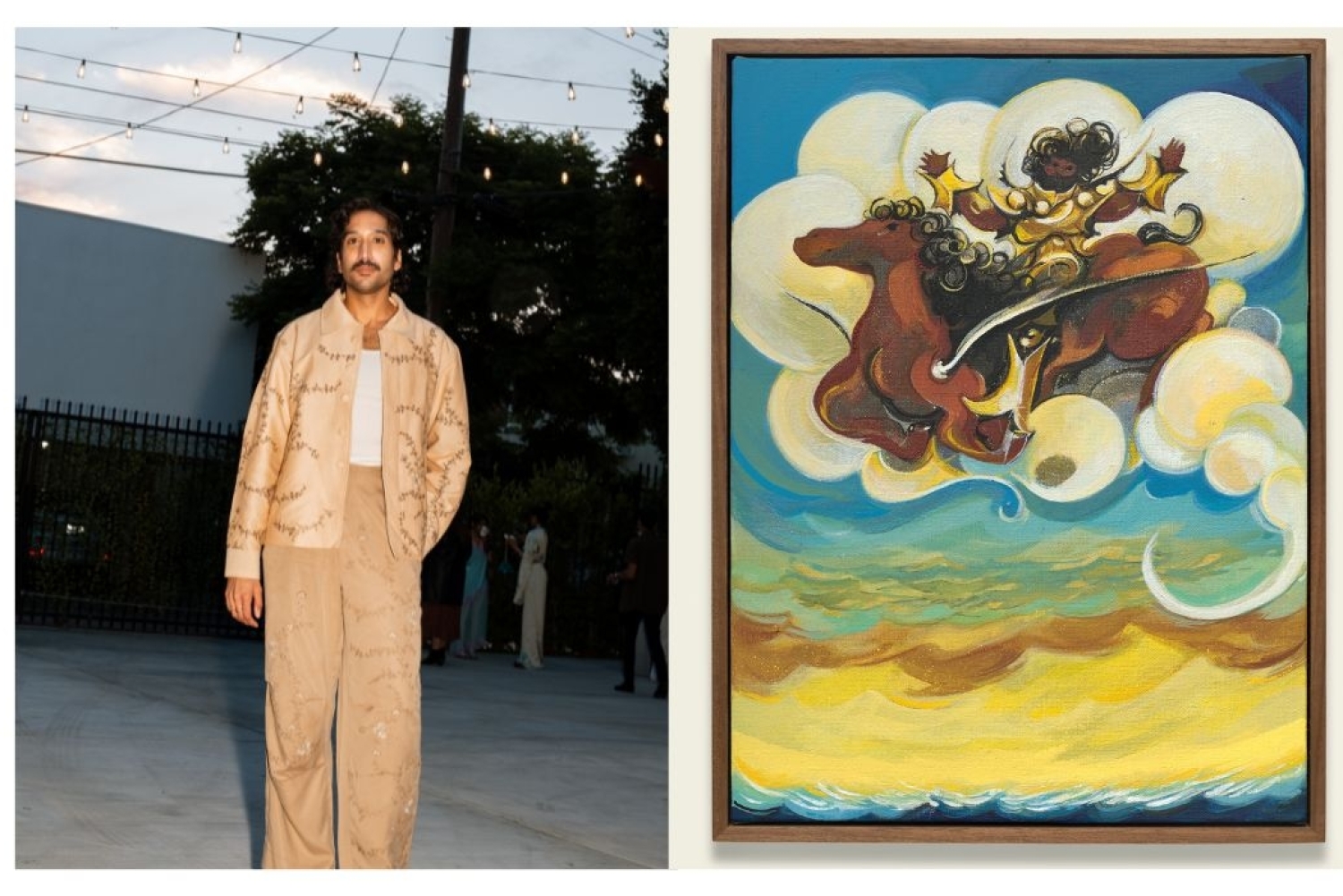
R: Rajiv Menon, photo by Simran Malik L: Up Up and Away by Asif Hoque

R: Rajiv Menon, photo by Simran Malik L: Up Up and Away by Asif Hoque
As a boy in Houston, Rajiv Menon would lose himself among towering canvases and echoing marble halls, his curiosity ignited by the city’s museum district. However, it was within the dark, bustling cinemas of Madras—surrounded by strangers and enveloped in a kaleidoscope of colour and music—that he truly discovered the electrifying possibilities of art that transcends language. Those formative moments—reading stories through images rather than words and sensing the pulse of another world without understanding a single line of dialogue—became the roots of his lifelong fascination.
Fast forward to today, and Rajiv is still crossing boundaries—only now, he turns crumbling Los Angeles office spaces into gorgeous sanctuaries for South Asian creativity. In his gallery, Rajiv Menon Contemporary, the mood is both electric and contemplative—a courtyard inspired by Kerala’s tropical modernism just steps away from the Hollywood hustle. Stop by for conversations about identity, diaspora, and what it truly means to be ‘home.’
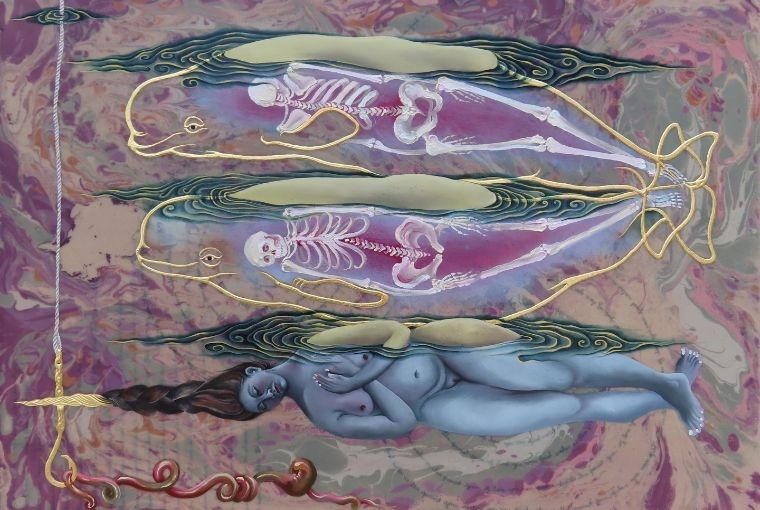
The People Under The Sea by Sahana Ramakrishnan
With the gallery, Rajiv is committed to showcasing artists of South Asian descent, particularly those working in the diaspora. His approach draws on a diverse academic background—combining a PhD in English with a concentration on visual and pop culture—and a deep familiarity with artistic communities in both the United States and India. Rajiv’s gallery exists not only to promote innovative contemporary art but also to encourage cultural exchange, dialogue, and education about the complexities of South Asian identity.
How did you conceptualize the design and ethos of your gallery?
I had a lot of architectural inspiration. I was really fortunate to work with our landlord and his team to really reshape the space, because it was a total gut renovation. I was thinking a lot about tropical modernism. I was thinking about architects like Geoffrey Bawa, and then later Bijoy Jain, and just the people I found very aesthetically inspiring. And I wanted the space to feel like a little piece of South Asia had been plopped right in the middle of Hollywood. I was thinking about the spaces that inspired me in Fort Cochin, where my dad grew up. I think a lot about Kerala as a huge inspiration for how I wanted to think about the space.
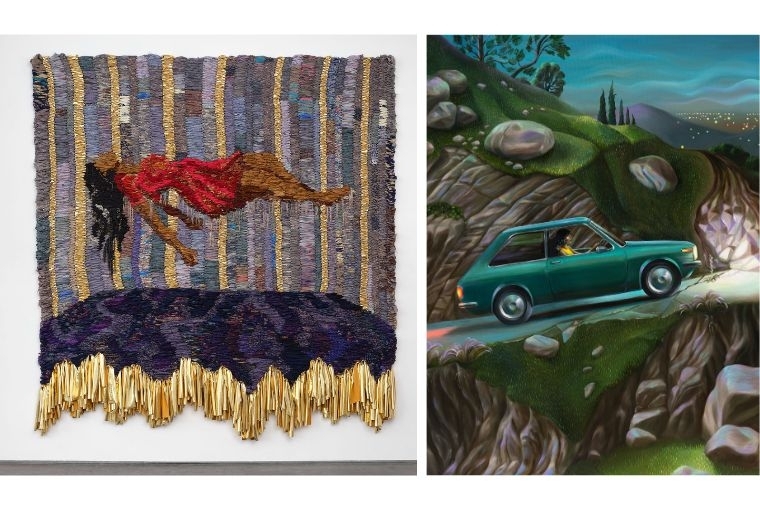
L: Set Free by Suchitra Mattai R: All Uphill From Here by Shyama Golden
How do you see the West perceiving South Asian culture and contemporary art, and what was your response to that in your work?
I felt that there was a strong need to educate people in the West about all the incredible creativity coming out of South Asia, because I felt that there was a real issue in the way it was being perceived. And it’s not exclusive to art. Whether it’s film or fashion, so often our work is treated as inferior or derivative or kitsch. A lot of the way that people were talking about South Asian art was similar. It was treated much more as decorative, or very much rooted within tradition, but it didn’t have much to offer to the contemporary. And I wanted to provide a rebuttal to that.
I wanted to show that our work was cutting edge, it was culturally significant, and it was globally relevant above and beyond the South Asian audience.
Can you talk about your recent exhibition with Viraj Khanna and the ideas behind it?
I first encountered Viraj’s work in person at The Habitat Centre in Delhi, but I had seen his work on Instagram and was really taken by it. I had a strong feeling that he was doing something unique and relevant. The response to the show, Why Did I Say Yes?, was so overwhelming, and it was very clear that not only was there a hunger for a South Asian art space on the West Coast, but I also really strongly felt that this is what I was meant to be doing. And that was very much the curatorial intent of the show. I wanted to show that art had a place in a larger cultural conversation. I wanted his artwork to also be in dialogue with film, like Monsoon Wedding, with novels like Crazy Rich Asians, and with TV shows like Made in Heaven. I felt that his work could transcend the art world and enter the culture in a meaningful way. And I felt that he had something really powerful to say about Indian weddings.
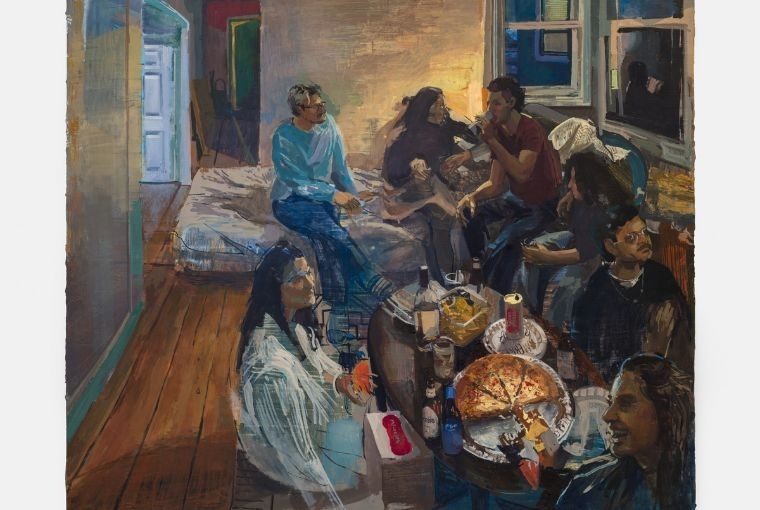
Thanksgiving by Ricky Vasan
What can you tell us about your upcoming show, Non-Residency, at the Jaipur Centre of Arts?
This was my way of wanting to enter the sense of cultural divide between the diaspora and our eyes and then the motherland... I wanted to showcase a cohort of artists that I believe are making those cultural waves. Most of them are showing in India for the first time. It’s a very monumental gesture to be able to bring artists back home and just show how culture evolves and changes outside of India, but how it can remain in dialogue with audiences in India. It’s at the City Palace at the Jaipur Centre for Arts. I think there’s something deliberate about the blurring of boundaries between diaspora and homeland that happens when you bring the work into such a significant space. The show is all curated around the experience of the uncanny. So the feeling of a distortion of the familiar, a sense of unsettling through something that seems like the same, but is quite different. And I felt that emotional experience defined the encounter between the diaspora and the homeland.
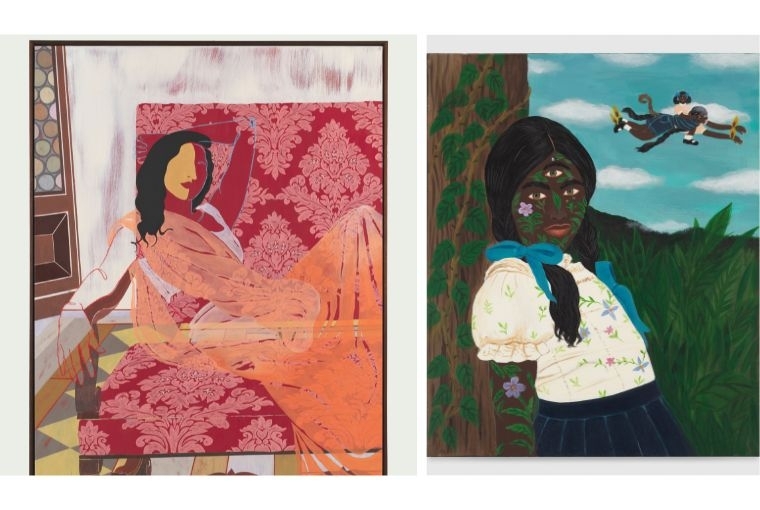
R: Untitled, Anoushka Mirchandani L: Kelly Sinnapah Mary's Violette's Book: The Girl with 3 Eyes, Credits: Christopher Burke Studio
The all new show by Rajiv Menon Contemporary opened yesterday at the Jaipur Centre of Art at the historic Jaipur City Palace marking the first international exhibition for the gallery. Non-Residency is on till the 5th of October, 2025.
This article is from our May Bookazine. Grab your copy here.
Words Hansika Lohani
Date 12-8-2025